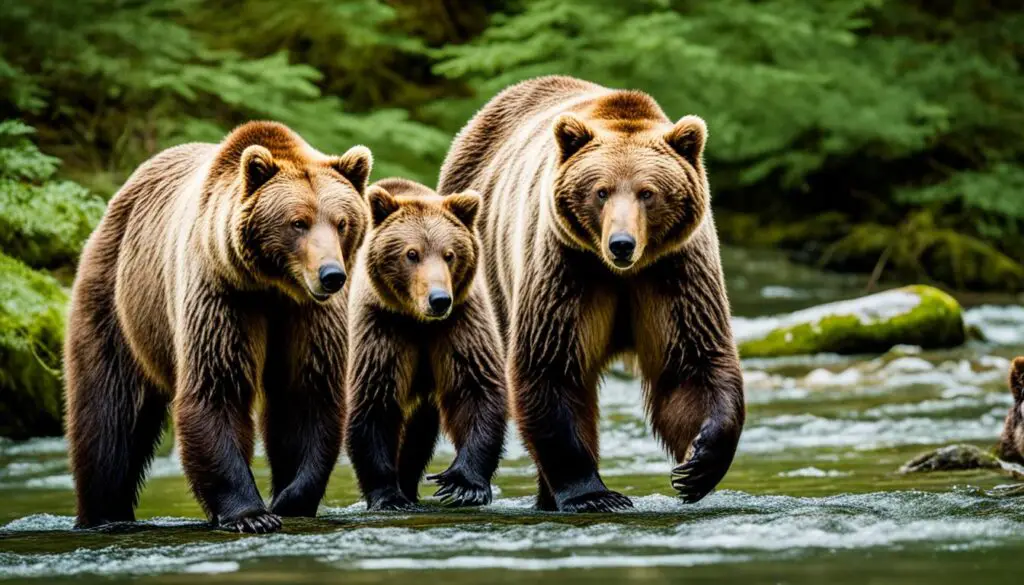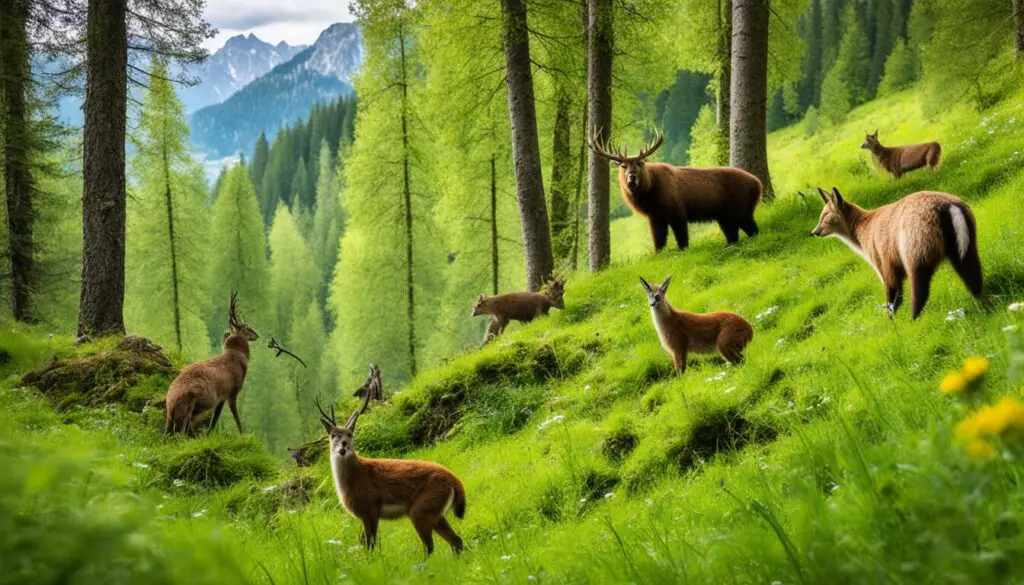Did you know that Slovenia, a small country in Central Europe, is home to an astonishing variety of animal species? With its diverse landscapes and pristine natural habitats, Slovenia boasts an impressive array of wildlife that captivates both locals and visitors alike. From the towering Julian Alps to the picturesque lakes and verdant forests, Slovenia’s natural wonders provide a haven for numerous animal species to thrive.

Key Takeaways:
- Slovenia is known for its rich biodiversity and diverse animal species.
- The country’s varied landscapes, including mountains, lakes, and forests, provide unique habitats for wildlife.
- Conservation efforts are vital to protect endangered species and preserve Slovenia’s remarkable natural heritage.
- Responsible animal tourism offers opportunities to engage with Slovenia’s wildlife while supporting conservation initiatives.
- Maintaining a balance between promoting tourism and protecting the environment is crucial for the long-term sustainability of Slovenia’s wildlife.
Fauna of Slovenia
Slovenia is home to a diverse array of animal species, showcasing the country’s rich biodiversity and offering nature enthusiasts a unique opportunity to observe the stunning wildlife. The fauna of Slovenia comprises both indigenous and migratory animals that thrive in the country’s various habitats, including forests, wetlands, and alpine regions.
Animals in Slovenia range from small and elusive creatures to larger mammals and a variety of avian species. The country’s diverse topography provides a suitable environment and abundant resources for a wide range of animals to flourish and coexist.
In the forests of Slovenia, visitors can spot animals such as the European brown bear, lynx, and chamois. These majestic creatures are among the highlights of the Slovenian wildlife, often captivating wildlife enthusiasts and nature photographers alike.
The rivers and lakes of Slovenia are teeming with life, hosting diverse aquatic species. From the iconic marble trout to the elusive Danube salmon, these waterways provide essential habitats for numerous fish species that contribute to the country’s thriving biodiversity.
Avian Species
The avian species found in Slovenia are equally impressive, with over 360 bird species recorded. These include majestic raptors like the golden eagle, falcons, and owls, as well as colorful songbirds like the European bee-eater and hoopoe.
During the seasonal migrations, Slovenia becomes a vital stopover point for a multitude of bird species. The extensive wetlands within the country, such as the famous Lake Cerknica, attract a large number of waterbirds seeking temporary refuge.
The biodiversity of Slovenia extends to its reptiles and amphibians. Visitors may encounter various species, including the rare olm, also known as the “human fish,” which resides in the country’s karst caves.
Exploring the fauna of Slovenia offers an immersive experience, where visitors can witness the wonders of nature up close. The unparalleled beauty and diversity of Slovenian wildlife make it an ideal destination for nature lovers and wildlife enthusiasts.
Endangered Species in Slovenia
Slovenia is home to a diverse range of wildlife, including many species that are classified as endangered. These endangered species face numerous challenges that threaten their survival, such as habitat loss, climate change, and poaching. In response to these threats, wildlife conservation efforts have been implemented in Slovenia to protect and preserve these precious animals.
Conservation Initiatives
Wildlife conservation in Slovenia is a top priority, and dedicated organizations, such as the Slovenian Forest Service and the Slovenian Environment Agency, work tirelessly to protect endangered species. Through various initiatives, these organizations strive to increase awareness, implement conservation strategies, and promote sustainable practices.
One such initiative is the establishment of protected areas, such as national parks and nature reserves, where endangered species can thrive in their natural habitats. These protected areas not only provide a safe haven for wildlife but also offer opportunities for research and educational activities.
Research plays a crucial role in the conservation and management of endangered species in Slovenia. Studies are conducted to monitor population trends, study behavior, and assess the impact of conservation efforts. This data helps inform decision-making processes and guides future conservation strategies.
Challenges and Threats
Endangered species in Slovenia face numerous challenges that put their survival at risk. Habitat fragmentation due to urbanization and agricultural expansion is a significant threat, as it restricts the movement and dispersal of wildlife populations.
Climate change also poses a significant challenge, affecting ecosystems and altering the availability of resources. Endangered species that depend on specific climatic conditions or have narrow habitat requirements are particularly vulnerable to these changes.
Poaching and illegal wildlife trafficking further exacerbate the risks faced by endangered species in Slovenia. To combat these activities, strict laws and regulations have been enacted, along with increased enforcement and public awareness campaigns.
Collaborative Efforts
Protecting endangered species in Slovenia requires collaboration and cooperation between government bodies, conservation organizations, local communities, and individuals. It is through these combined efforts that significant progress can be made in preserving the country’s unique biodiversity.
Volunteer programs and citizen science initiatives allow individuals to actively contribute to wildlife conservation. These programs provide opportunities for direct involvement in fieldwork, monitoring, and raising awareness about endangered species and their habitats.
Education also plays a crucial role in fostering a sense of responsibility towards wildlife conservation. Schools, nature centers, and environmental organizations offer educational programs to raise awareness among both young people and adults about the importance of protecting endangered species and their habitats.
By working together, Slovenia continues to make strides in the conservation of its endangered species. Through ongoing research, conservation initiatives, and collaborative efforts, the country’s wildlife is given a fighting chance for a thriving future.
Protected Animals in Slovenia
In Slovenia, the protection of wildlife is of utmost importance. The country takes significant measures to safeguard its diverse range of animal species and their habitats. These measures are crucial for the long-term preservation of Slovenia’s biodiversity and contribute to the overall goal of wildlife conservation in Slovenia.
Protected Animal Species
Slovenian law grants protection to a variety of animal species native to the country. These protected animals in Slovenia include:
| Animal Species | Habitats | Conservation Status |
|---|---|---|
| 1. European brown bear | Forests and mountains | Endangered |
| 2. Alpine ibex | Alpine regions | Vulnerable |
| 3. Eurasian lynx | Forests | Endangered |
| 4. Carniolan honey bee | Beehives and rural areas | Endangered |
| 5. Dalmatian pelican | Wetlands and lakes | Vulnerable |
These species are just a few examples of the many animals protected under Slovenian law. The comprehensive list includes various birds, mammals, reptiles, amphibians, and insects, all of which play a vital role in maintaining the ecological balance of the region.
The habitats of these protected animals are also prioritized for conservation efforts. Slovenian authorities implement strict regulations to preserve the forests, mountains, wetlands, and other natural areas where these animals reside.

The image above showcases the beautiful landscape of Slovenia, which serves as a home to these protected animals. It represents the country’s commitment to wildlife conservation and the preservation of its natural heritage.
By safeguarding these animals and their habitats, Slovenia aims to maintain its rich biodiversity and provide future generations with the opportunity to witness the wonders of its wildlife. The protection of these animals not only ensures their survival but also contributes to the overall health of the ecosystem and promotes sustainable tourism that allows visitors to appreciate Slovenia’s natural treasures responsibly.
Slovenia Animal Tourism
Slovenia’s stunning natural landscapes and diverse wildlife make it a prime destination for animal tourism. Visitors have the opportunity to engage with the country’s wildlife while also supporting wildlife conservation efforts.
Responsible animal encounters
When participating in animal tourism activities in Slovenia, it is crucial to choose responsible and ethical options. Opt for experiences that prioritize the well-being and conservation of the animals. These activities often include wildlife watching, guided nature walks, and educational programs that promote appreciation and understanding of Slovenia’s unique fauna.
Supporting conservation efforts
By engaging in animal tourism in Slovenia, visitors contribute directly to wildlife conservation efforts. Sustainable tour operators reinvest a portion of their proceeds into conservation initiatives, helping to protect and preserve the country’s natural habitats and endangered species.

The benefits of animal tourism
- Increased awareness: Animal tourism provides opportunities for visitors to learn about the importance of wildlife conservation and biodiversity.
- Positive economic impact: The revenue generated from animal tourism supports local communities and conservation efforts, promoting the long-term sustainability of wildlife habitats.
- Research and monitoring: Many animal tourism activities assist in gathering valuable data for scientific research and conservation management.
Considerations and potential risks
While animal tourism can have positive impacts, it’s essential to be aware of potential risks and choose activities that prioritize animal welfare and sustainability. Avoid engaging in activities that involve physical contact or exploitation of the animals and familiarize yourself with responsible wildlife tourism guidelines.
Overall, Slovenia offers a unique opportunity for individuals to experience its remarkable wildlife while actively contributing to its conservation. By embracing responsible animal tourism practices, visitors can help protect the country’s rich natural heritage for future generations.
Conclusion
In conclusion, Slovenia is a haven for diverse and fascinating animals. The country’s rich biodiversity, including its distinctive Slovenian wildlife, is a testament to the importance of preserving and protecting the natural environment. From the stunning Alpine peaks to the lush forests and pristine rivers, Slovenia provides a thriving habitat for a wide variety of animal species.
Throughout this article, we have explored the different facets of Slovenia’s wildlife. We have discussed the endangered species that require special attention and conservation efforts to ensure their survival, as well as the protected animals that are safeguarded under Slovenian law.
Furthermore, we have delved into the opportunities for animal tourism in Slovenia, highlighting the responsible ways visitors can engage with the country’s wildlife while supporting wildlife conservation initiatives. It is crucial, however, to strike a balance between promoting tourism and safeguarding the natural environment to maintain the delicate harmony between humans and animals in Slovenia.
In order to protect and preserve the animals in Slovenia, their habitats, and the overall biodiversity of the country, it is essential for both locals and tourists to prioritize wildlife conservation. By raising awareness, supporting sustainable practices, and respecting the wildlife and their natural habitats, we can ensure that future generations will be able to experience the beauty and wonder of Slovenia’s animal kingdom.
